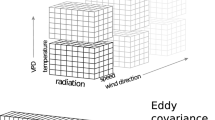Abstract
When density fluctuations of scalars such as CO2 are measured with open-path gas analyzers, the measured vertical turbulent flux must be adjusted to take into account fluctuations induced by ‘external effects’ such as temperature and water vapour. These adjustments are needed to separate the effects of surface fluxes responsible for ‘natural’ fluctuations in CO2 concentration from these external effects. Analogous to vertical fluxes, simplified expressions for separating the ‘external effects’ from higher-order scalar density turbulence statistics are derived. The level of complexity in terms of input to these expressions are analogous to that of the Webb–Pearman–Leuning (WPL), and are shown to be consistent with the conservation of dry air. It is demonstrated that both higher-order turbulent moments such as the scalar variances, the mixed velocity-scalar covariances, and the two-scalar covariance require significant adjustments due to ‘external effects’. The impact of these adjustments on the turbulent CO2 spectra, probability density function, and dimensionless similarity functions derived from flux-variance relationships are also discussed.
Similar content being viewed by others
References
Aubinet M, Berbigier P, Bernhofer CH, Cescatti A, Feigenwinter C, Granier A, Grunwald TH, Havrankova K, Heinesch B, Longdoz B, Marcolla B, Montagnani L, Sedlak P (2005) Comparing CO2 storage and advection conditions at night at different carboeuroflux sites. Boundary-Layer Meteorol 116:63–94
Baldocchi D, Falge E, Gu LH, Olson R, Hollinger D, Running S, Anthoni P, Bernhofer C, Davis K, Evans R, Fuentes J, Goldstein A, Katul G, Law B, Lee XH, Malhi Y, Meyers T, Munger W, Oechel W, U KTP, Pilegaard K, Schmid HP, Valentini R, Verma S, Vesala T, Wilson K, Wofsy S (2001) FLUXNET: a new tool to study the temporal and spatial variability of ecosystem-scale carbon dioxide, water vapor, and energy flux densities. Bull Am Meteorol Soc 82:2415–2434
Choi TJ, Hong JY, Kim J, Lee HC, Asanuma J, Ishikawa H, Tsukamoto O, Gao ZQ, Ma YM, Ueno K, Wang JM, Koike T, Yasunari T (2004) Turbulent exchange of heat, water vapor, and momentum over a Tibetan prairie by eddy covariance and flux variance measurements. J Geophys Res Atmos 109:D21106 doi:10.1029/2004JD004767
de Arellano JVG, Gioli B, Miglietta F, Jonker HJJ, Baltink HK, Hutjes RWA, Holtslag AAM (2004) Entrainment process of carbon dioxide in the atmospheric boundary layer. J Geophys Res Atmos 109:D18110, doi:10.1029/2004JD004725
Feigenwinter C, Bernhofer C, Vogt R (2004) The influence of advection on the short term CO2-budget in and above a forest canopy. Boundary-Layer Meteorol 113:201–224
Fuehrer PL, Friehe CA (2002) Flux corrections revisited. Boundary-Layer Meteorol 102:415–457
Juang J-Y, Katul GG, Siqueira MB, Stoy PC, Palmroth S, McCarthy HR, Kim HS, Oren R (2006) Modeling nighttime ecosystem respiration from measured CO2 concentration and air temperature profiles using inverse methods, J Geophys Res Atmos 111, D08S05, doi:10.1029/2005JD005976
Katul GG, Geron CD, Hsieh CI, Vidakovic B, Guenther AB (1998) Active turbulence and scalar transport near the land-atmosphere interface. J Appl Meteorol 37:1533–1546
Katul GG, Goltz SM, Hsieh CI, Cheng Y, Mowry F, Sigmon J (1995) Estimation of surface heat and momentum fluxes using the flux-variance method above uniform and non-uniform terrain. Boundary-Layer Meteorol 74:237–260
Liebethal C, Foken T (2003) On the significance of the Webb correction to fluxes. Boundary-Layer Meteorol 109:99–106
Liu HP (2005) An alternative approach for CO2 flux correction caused by heat and water vapour transfer. Boundary-Layer Meteorol 115:151–168
Massman WJ, Lee X (2002) Eddy covariance flux corrections and uncertainties in long-term studies of carbon and energy exchanges. Agric Forest Meteorol 113:121–144
Moriwaki R, Kanda M (2004) Seasonal and diurnal fluxes of radiation, heat, water vapor, and carbon dioxide over a suburban area. J Appl Meteorol 43(11):1700–1710
Novick KA, Stoy PC, Katul GG, Ellsworth DS, Siqueira MBS, Juang J, Oren R (2004) Carbon dioxide and water vapor exchange in a warm temperate grassland. Oecologia 138:259–274
Scanlon TM, Albertson JD (2001) Turbulent transport of carbon dioxide and water vapor within a vegetation canopy during unstable conditions: Identification of episodes using wavelet analysis. J Geophys Res Atmos 106:7251–7262
Siqueira M, Lai CT, Katul G (2000) Estimating scalar sources, sinks, and fluxes in a forest canopy using Lagrangian, Eulerian, and hybrid inverse models. J Geophys Res Atmos 105:29475–29488
Staebler RM, Fitzjarrald DR (2004) Observing subcanopy CO2 advection. Agric Forest Meteorol 122:139–156
Webb EK, Pearman GI, Leuning R (1980) Correction of flux measurements for density effects due to heat and water-vapor transfer. Quart J Roy Meteorol Soc 106:85–100
Author information
Authors and Affiliations
Corresponding author
Rights and permissions
About this article
Cite this article
Detto, M., Katul, G.G. Simplified expressions for adjusting higher-order turbulent statistics obtained from open path gas analyzers. Boundary-Layer Meteorol 122, 205–216 (2007). https://doi.org/10.1007/s10546-006-9105-1
Received:
Accepted:
Published:
Issue Date:
DOI: https://doi.org/10.1007/s10546-006-9105-1



